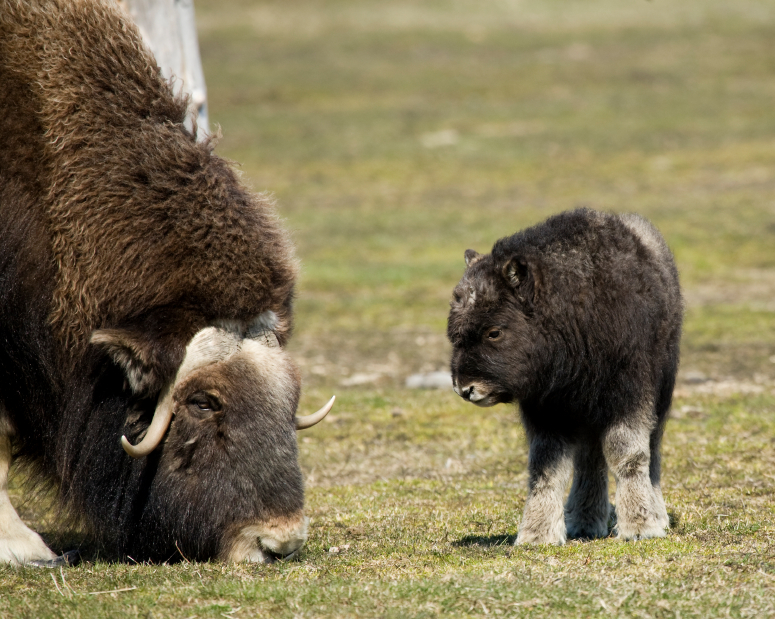Musk ox invasion keeps wildlife managers busy in Alaskan city

Nome is used to rowdy residents, but some relatively new transplants are making a real nuisance of themselves — although unlike the colorful characters of the early 20th century gold rush days, these visitors have four legs, not two.
Musk oxen are wandering into the city on Alaska’s Seward Peninsula, and despite loud noises, water hoses and even a blow-up bear coated in ursine urine, they don’t want to leave.
The animals — actually more closely related to goats and sheep than to oxen — are large, hairy and, as their name implies, smelly, thanks to a scent gland males use to attract mates. With large horns, standing up to 5 feet tall and weighing in at close to half a ton, musk oxen can pose a threat to people and pets that either get too close or attract the hulking animals’ ire. There are an estimated 100 musk oxen near Nome, in about four or five different groups, according to Tony Gorn, a wildlife biologist for the Alaska Department of Fish and Game.
Gorn said several dogs have been killed by the musk oxen, although so far, no people have been hurt.
‘Re-herding’ away from city
But daily calls from people who find the animals have gotten too close for comfort mean Gorn is spending a lot of time this summer herding — and re-herding — the musk oxen away from the city of Nome.
“A group that I moved two days ago at four in the morning are back,” Gorn said as he got ready Wednesday afternoon to again try to get the musk oxen to go away for good. “I moved them several miles away and they are slowly working their way back,” Gorn said.
Musk oxen, it turns out, are hard to deter. Gorn said the animals are unusually patient with people, often allowing them to get a little too close for Gorn’s comfort. Loud noises, car horns, and yelling and stomping the ground only get the animals to move away from town temporarily. At the Nome airport, which has seen several musk oxen venture onto its runway this year, the best measure so far seems to be the use of the fire truck to spray the animals down with water.
“They don’t like water,” said Nome airport manager Robert Madden.
But Madden has been experimenting with using other means to keep the animals off his runways.
Since June 28, he has been experimenting with an inflatable bear effigy with bear urine spread around it.
“I haven’t seen any since then,” Madden said.
But the bear urine — bought online — might not be the musk oxen’s blue ticket out of town everyone hopes it is. Gorn is trying it as well, leaving it around Nome in areas where the musk oxen like to gather.
“Frankly, if anything, it kind of shows some desperation here,” Gorn said.
Co-existing with people
Musk oxen were once prevalent throughout Alaska’s northern and western regions, but they were hunted to extinction in the 1800s. The animals were reintroduced in the Nome area in the 1970s, and they flourished. A population that began as 30 animals is now estimated to be in the thousands. But the area musk oxen population is declining at a rate of about 13 percent per year, according to Gorn.
Despite there being fewer musk oxen on the Seward Peninsula — the land mass that stretches into the Bering Sea on Alaska’s west coast at the state mainland’s closest point to Russia — the animals are being spotted more frequently near people, something that almost never happened until about five years ago. No one knows why the musk oxen have decided to make Nome their summer stopover, although Gorn said it may be because the animals are trying to get away from bears. Without an accurate count of the number of bears in the area, though, Gorn was reluctant to officially pin the visits on predators.
Whatever the reason, Nome residents are likely to encounter musk oxen on streets and in parking lots and yards — especially on the outskirts of the small town. Most of the time, the encounters are harmless. But Gorn said the animals have become a polarizing presence in Nome.
“There’s a segment of community that is understandably frustrated and also a segment that really enjoys having wildlife in their backyards,” Gorn said.
The musk oxen usually leave town as winter approaches, looking for less-snowy places to call home. Until they do, Gorn said, the best way to avoid problems with the animals is to give them space and keep pets and gardens behind chain link fences.
Related stories from around the North:
Canada: Wildlife endangered by Yukon warm weather, CBC News
Finland: Developing wildlife tourism good for Finland say experts, Yle News
Sweden: Motorists warned to watch out for wildlife on Sweden’s roads, Radio Sweden
United States: Alaska pilots face urban wildlife threat from musk ox, Alaska Dispatch



